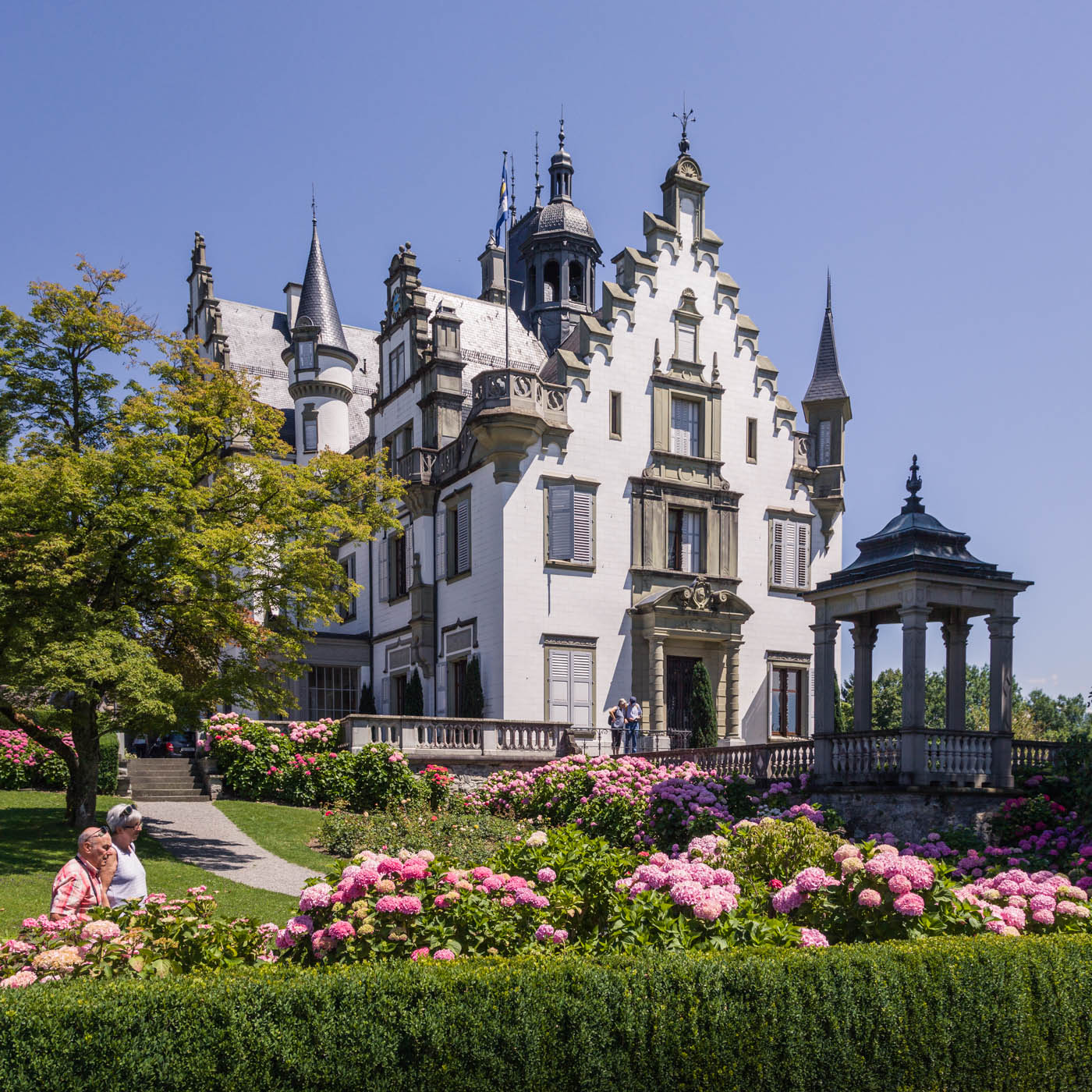Picture above is Heidegg Castle
Take a journey to some of Switzerland's most beautiful and historical landmarks.
Hello and welcome to my guide to Swiss Castles, which I have personally compiled for all to enjoy, showcasing some of the most fascinating and historically significant landmarks from across Switzerland. Each castle has its own story to tell, in a beautiful setting, with exhibitions, guided tours and re-enactments for recreational and educational purposes, or simply as an adventurous outing. I wish you a pleasant journey while exploring this guide.
All the these landmarks have been visited, photographed and cataloged by the me for this website. This was done on a voluntarily bases without any financial support from anyone. Raymond Inauen
★★★★
Heidegg Castle
A garden paradise in miniature with a love of roses and a spectacular view of the surrounding landscape and the Alps. Heidegg castle sits on its pedestal overlooking 800 years of history that has been lovingly restored for all to enjoy, young and old.
Located in the municipality of Gelfingen in the Seetal of Lucerne, the drive up to this castle is rewarded with a beautiful view of the vineyards that rise up to the castle walls. The beautifully restored grounds and museum are waiting for the castle hungry visitors, but don’t forget to visit the rose garden it’s the icing on the cake.
Castle ★★★★ | Museum ★★★★ | Gardens ★★★★★
★★★★
Spiez Castle
Spiez Castle was built in 933 AD and is one of the oldest castles in Switzerland.
Strategically located, the castle with its magnificent view of Lake Thun is now a popular stopover when travelling in the Bernese Oberland. Visitors can explore the museum's collections and exhibits, enjoy the castle, park and church or have a drink in the castle café. The castle can be booked for weddings and events.
Castle ★★★★ | Gardens ★★★★
View ★★★★★
★★★★
Wyher Castle
This beautifully restored castle with moat and turrets is now a popular location for weddings and events.
The castle was once owned by Colonel Ludwid Pfyffer, “Roi de Suisse” an important Swiss political figure from the 16th century. Following a fire in 1963 that nearly destroy the manor house, the canton of Lucerne purchased the ruin and established a foundation to restore the moated castle to its former glory. All be it the castle isn’t open to the public, it still is a remarkable example of the effort taken to save a beautiful monument.
Castle ★★★ | Grounds ★★★★
★★★★★
Meggenhorn Castle
Cinderalla or maybe Snow White, whichever, this castle is for romantic adventures with a happy ending.
Meggenhorn castle is a fairy tale castle sitting on a hill that overlooks lake Lucerne, Lucerne city, Pilatus, Rigi and the Alps that span along the whole horizon. How much more cheesy can you get. The manicured gardens flow around the building, inviting to sit and enjoy the flowers and ponder the spectacular view. The many castle windows and turrets invite to dream even more. Why are you still here, a romantic dream is waiting to be experienced.
Castle ★★★★★ | Gardens ★★★★★
View ★★★★★
Swiss History
Battle of Morgarten in 1315
The rise of the Swiss Confederacy
The Battle of Morgarten occurred on 15 November 1315, when a 1,500-strong force from the Swiss Confederacy ambushed a group of Habsburg soldiers on the shores of Lake Ägeri near the Morgarten Pass in Switzerland.
★★★★
Rapperswil Castle
Located at the bottom of lake Zurich, Rapperswil castle dominates above the harbor and the old town. Restored in the 19th century, it now houses the Polish museum and other exhibitions sponsored by the museum.
The park that surrounds the castle is very popular because of the view overlooking the rooftops, lake, harbor and the alps. Many visitors will also spend time walking through the historical inner city, enjoying the beautiful architecture and wonderful atmosphere. The walk along the lake is also a popular excursion and all of this is easily accessible by foot.
Castle ★★★★ | Park ★★★★ | View ★★★★
★★★★
Chillon Castle
Chillon Castle sits on a small island along the shoreline of lake Geneva in the canton of Vaud. It is situated at the eastern end of the lake, between Montreux and Villeneuve. It’s one of the most visited castles in Switzerland.
Castle ★★★★★ | Museum ★★★★ | View ★★★★
If you have built castles in the air, your work need not be lost; that is where they should be. Now put the foundations under them.
Henry David Thoreau
★★★★
Lenzburg Castle
Opened up to the public in 1986, this wonderfully restored medieval castle is a very popular attraction in the Aargau region. The castle is also one of Switzerland’s oldest and most important castles, with a long history of counts and dukes having lived there.
With its commanding placement over the town of Lenzburg and the surrounding region, the castle has been the place of settlement since Neolithic period. Today the castle is a popular tourist attraction as well as offering the use of its space for weddings, business and cultural events. All of this is set in a beautiful medieval surrounding, with an impressive courtyard and garden. This also is the ideal castle for a family outing, where the kids have plenty of learning activities that they can experience while exploring the castle museum.
Castle ★★★★ | Museum ★★★★ | Gardens ★★★★ | View ★★★★
★★★
Kappel am Albis Monastery
Probably one of the best kept secrets in the canton of Zurich, Kappel am Albis abbey stands out with its church spire over the rolling countryside that is dotted by small towns and farmland. Situated on plateau, the view of the alps and the city of Zug and its lake only add to the magic of the region.
Historically the abbey is also located on a famous battle field that took place in 1529. The battle however was never fought and the famous story of the Kappeler Milchsuppe became legend. The opposing troops decided to share their food rations while diplomatic talks where being held. In the end a diplomatic compromise was found and no lives where lost. Maybe the real reason for not going to war was the breathtaking view that overwhelmed the combatants so much so they decide it wasn’t worth spilling any blood that day.
Monastery ★★★ | Gardens ★★★ | View ★★★★★
★★★★★
Hallwyl Castle
Mirror, mirror, on the wall, – who is the fairest one of all? The answer is Hallwyl castle with its beautiful moat, presenting the perfect reflection in emerald colors of the castles walls, its turrets and bridge.
The Castle is one of the most important moated castles in Switzerland. It's located on two small islands in the River Aabach, on the northern end of lake Hallwil. Beautifully restored, it's a pure delight to visit and explore. Perfectly manicured, a charming museum with shop and restaurant, the castle is a perfect escape form city stress.
Castle ★★★★★ | Museum ★★★★★ | Grounds ★★★★
Many of these monuments have been lovingly restored
★★★★★
Wildegg Castle
Propped up on a hillside overlooking the river Aare the castle has a commanding view over the entire valley below. Terraced with vineyards and gardens and a beautifully managed rose garden, the castle invites to discover it’s many facets, inside and out.
In 2011 the castle was renovated and now belongs to the canton of Aargau. Wildegg is at the top of a string of castles that include Lenzburg castle, visible just to the south, Hallwyl castle in the middle, and at the bottom Heidegg castle. Wildegg has its own charm, with plenty of things to discover for younger and older generations, from the outside all the way to its most inner core. If your are going to stage a castle hopping tour, it might be a good idea to start here and work your way southwards on a journey through medieval history.
Castle ★★★★★ | Museum ★★★★★ | Grounds ★★★★
An oath sworn that bound a nation.
There was an age when Switzerland was surrounded by envious kingdoms who's only interest in the land were strategic gateways leading south through narrow and difficult alpine passageways, enabling the so important trade in goods and wealth. These important routes passed through the heart of Europe and a people of special character, considered poor, primitive and easy to conquer. With this the spark of rebellion began to brew due to the bad treatment and lack of respect for the local population, which seemed to be of little value and easy to overrun. This seething pot of discontent led to the foundation of the Swiss Confederation in 1291 and the beginning of a long and bloody conflict that would last for several centuries. The struggle for independence from subjugation began behind the fortifications and on the battlefield with a discipline and training that produced some of the finest warriors in Europe who ever engaged in battle. As Switzerland's prestige grew with each new battle won, its enemies became patrons, recruiting the Swiss as mercenaries to serve the kings of Europe and, last but not least, as a crowning jewel, to become the personal guard of the Pope in Rome. This achievement can be discovered when visiting the many castles that dot the landscape of this beautiful country from the many years of war going back to the middle ages. The heritage is full of mysticism and folklore, but at its heart Switzerland is a nation with a long tradition of strength and pride best reflect by the many castles that now remain.
★★★★★
Villa Patumbah
The Villa Patumbah was built between 1863 and 1885 for Karl Fürchtegott Grob. The villa is one of the most important witnesses of historicism in Zurich and is a protected monument.
Villa ★★★★★ | Museum ★★★★ | Park ★★★★
★★★
Mauensee Castle
Mauensee Castle located close to Sursee in the canton of Lucerne, is a privately own property located on a small island with a private wooden bridge to access the island.
Castle ★★★ | View ★★★
99.99% of all castles in America are located in fish tanks.
Demetri Martin
Swiss History
A soup that ended a war
Kappel am Albis and its historic Significance
Kappeler Milchsuppe is a Swiss milk soup with quite a history. Its origin goes all the way back to 1529. Legend has it that this soup was created by hungry infantrymen. They were on opposite sides of a conflict between Catholics and Protestants, but they put down their weapons and pooled their milk and bread to make and share soup. That soup is now credited with bringing peace to the region and honored with a memorial on a battlefield. Now, that’s an impressive soup. It’s still served in Switzerland to this day. Let’s grab a bowl.
★★★
Regensberg Castle
Located on a hilltop, the original castle walls no longer exist and have been replaced by a ring of buildings that now make up the hilltop town. All that remains now is a tower that over looks the village below and the fantastic view that extends all the way to the boarders of Germany.
Castle ★★★ | Grounds ★★★★ | View ★★★★
★★★
Uster Castle
Perched up above Uster on a small hill, this inconspicuous castle is ignored by the passing traffic below. Of little historical importance and now converted into a school, Uster castle will never gain the same share of attention as some other castles in the region like Kyburg castle.
Castle ★★★ | Interior ★★★ | View ★★★★
★★★★★
Einsiedeln Monastery
Einseideln abbey is one of the largest monasteries in Switzerland. Its imposing church in the Baroque style have made it one of the most popular tourist attractions in the country.
Alone the size of its grounds and different buildings that surround the main church are an indication of how important the abbey once was and still is. Today it still supports a large number of different trades that are needed to keep the grounds and its buildings functioning. The monastery also boasts its very own stables and vinery as well as very beautiful library. The adjacent town of Einsiedeln has also become very popular with tourist, that enjoy the local specialities and shops.
Monastery ★★★★ | Grounds ★★★★ | View ★★★★
Swiss Histroy
Swiss Warriors and Mercenaries
Our animated historical documentary series on the Evolution of Armies and Tactics continues with a video on the rise of the Swiss warriors and mercenaries during the Middle Ages and the Pike and Shot Era.
★★★★★
Kyburg Castle
Kyburg, one of the oldest castle museums in Switzerland and an important stop for castle lovers in the Zurich region.
Located next to the village of Kyburg, the castle offers a wide rage of experience beginning with its imposing view overlooking the river Töss and the surrounding landscape. Often remembered for its famous Iron Maiden, the resent renovations and changes to the exhibitions make this a wonderful castle to explore.
Castle ★★★★★ | Meseum ★★★★★ View ★★★★
★★★★★
St. Michael Monastry
A hidden jewel for treasure seekers.
Perched on a small hill that overlooks the town of Beromünster, this monastery is a hidden jewel for treasure seekers that want to discover the truly charming village like atmosphere.
Monastery ★★★★★
Chancellery ★★★★★
Foundation ★★★★
View ★★★★
Here are all the castle loctions listed from this website.
This website is dedicated to discovering some of the best preserved or restored castles, that once dominated this country’s landscape. There are over 500 castles and forts, scattered over a wide ranging landscape, of which only a few will be restored and the rest of which will remain ruins forever. Many of these fortifications lay along some of the most important trade routes in Europe, while others are simply "nouveau riche" houses built over the last 200 years. On this website you will find a small selection of these beautiful locations that you might want to discover.
Definitions
Castle
A castle (from Latin: castellum) is a type of fortified structure built in Europe and the Middle East during the Middle Ages by European nobility. Scholars debate the scope of the word castle, but usually consider it to be the private fortified residence of a lord or noble. This is distinct from a palace, which is not fortified; from a fortress, which was not always a residence for nobility; and from a fortified settlement, which was a public defence – though there are many similarities among these types of construction. Usage of the term has varied over time and has been applied to structures as diverse as hill forts and country houses. Over the approximately 900 years that castles were built, they took on a great many forms with many different features, although some, such as curtain walls and arrowslits, were commonplace.
Villa
A villa was originally an ancient Roman upper-class country house. Since its origins in the Roman villa, the idea and function of a villa have evolved considerably. After the fall of the Roman Republic, villas became small farming compounds, which were increasingly fortified in Late Antiquity, sometimes transferred to the Church for reuse as a monastery. Then they gradually re-evolved through the Middle Ages into elegant upper-class country homes. In modern parlance, 'villa' can refer to various types and sizes of residences, ranging from the suburban "semi-detached" double villa to residences in the wildland–urban interface.
Monastery
A monastery is a building or complex of buildings comprising the domestic quarters and workplaces of monastics, monks or nuns, whether living in communities or alone (hermits). A monastery generally includes a place reserved for prayer which may be a chapel, church or temple, and may also serve as an oratory.
Monasteries vary greatly in size, comprising a small dwelling accommodating only a hermit, or in the case of communities anything from a single building housing only one senior and two or three junior monks or nuns, to vast complexes and estates housing tens or hundreds. A monastery complex typically comprises a number of buildings which include a church, dormitory, cloister, refectory, library, balneary and infirmary. Depending on the location, the monastic order and the occupation of its inhabitants, the complex may also include a wide range of buildings that facilitate self-sufficiency and service to the community. These may include a hospice, a school and a range of agricultural and manufacturing buildings such as a barn, a forge or a brewery.












































